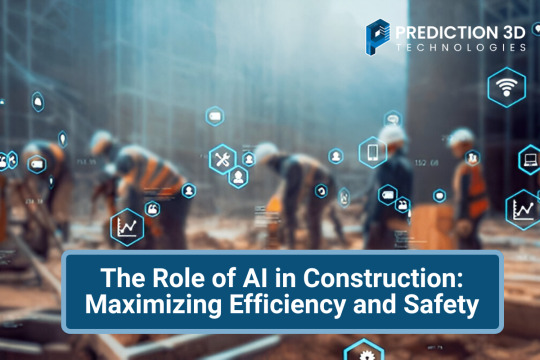#AI in estimating
Explore tagged Tumblr posts
Text
The Digital Shift | How Tech is Redefining Industrial Estimating Service
Introduction: The Role of Technology in Modern Industrial Estimating The industrial sector, once reliant on traditional methods of estimating project costs, has entered a new era where technology is reshaping how projects are planned, managed, and executed. In particular, industrial estimating services are benefiting from the integration of cutting-edge technology that enhances accuracy, efficiency, and overall project outcomes. As industries adopt advanced digital tools, the way cost estimates are generated and managed has evolved significantly, streamlining workflows, improving decision-making, and reducing the risks associated with manual errors and outdated practices.
The Shift from Manual Estimating to Digital Tools For many years, industrial estimating was a manual process that involved spreadsheets, paper-based plans, and extensive calculations. While these methods worked, they were time-consuming and prone to human error. Today, however, digital tools such as Building Information Modeling (BIM), 3D modeling, cloud-based estimating software, and artificial intelligence (AI) are transforming how industrial projects are estimated.
These technologies provide estimators with more powerful, accurate, and efficient means of calculating project costs. For instance, BIM allows for the creation of detailed, 3D models of a project, enabling estimators to visualize the design and identify potential issues before construction begins. This can lead to more accurate estimates and fewer surprises during the construction phase.
Building Information Modeling (BIM): Revolutionizing the Estimating Process BIM has revolutionized the way construction projects are designed and estimated. In industrial projects, BIM provides a detailed, virtual representation of the entire project, including every structural element, material, and system. This digital model allows estimators to see the project in its entirety and calculate accurate costs based on real-time data.
BIM helps estimators identify potential conflicts or inefficiencies in the design early on, reducing the likelihood of costly mistakes. For example, by modeling the mechanical, electrical, and plumbing systems in 3D, estimators can spot clashes or design issues that may lead to delays or cost overruns. This proactive approach allows estimators to adjust the design or budget before construction begins, improving the overall accuracy of the estimate.
Moreover, BIM allows for seamless collaboration between different stakeholders, such as architects, engineers, and contractors. Estimators can share the digital model with the entire project team, ensuring that everyone is on the same page and working toward the same goal.
Cloud-Based Estimating Software: Collaboration and Accessibility Cloud-based estimating software has become a game-changer for industrial estimating services. Unlike traditional desktop-based software, cloud-based solutions allow estimators to access project data from anywhere, at any time. This enhances collaboration between team members, contractors, and clients, as everyone can work from the same platform and update the estimate in real time.
Cloud-based software also provides the flexibility to store and organize vast amounts of project data, including cost breakdowns, material lists, and labor schedules. This data is securely stored in the cloud, ensuring that project details are accessible and up-to-date, even as changes occur during the project's lifecycle.
Additionally, cloud-based software can integrate with other project management tools, such as scheduling and procurement software. This enables estimators to track changes in real-time and adjust the cost estimates accordingly. For example, if there is a delay in material delivery, the estimator can update the estimate immediately, helping to keep the project on track and prevent cost overruns.
Artificial Intelligence and Machine Learning: Predictive Estimating Artificial intelligence (AI) and machine learning (ML) are increasingly being used in industrial estimating services to improve the accuracy and efficiency of cost predictions. By analyzing vast amounts of historical data, AI and ML algorithms can identify patterns and trends that human estimators may overlook.
For example, AI can help predict material costs based on historical pricing data, accounting for factors like inflation and market fluctuations. This allows estimators to generate more accurate cost projections, even in volatile markets. AI can also help identify potential risks, such as supply chain disruptions, that may impact project timelines or costs.
Machine learning algorithms can continuously improve over time as they are exposed to more data, allowing estimators to refine their predictions and enhance their accuracy. The ability to leverage AI and ML in the estimating process helps reduce the likelihood of cost overruns and ensures that projects stay within budget.
Real-Time Data and Analytics: Making Informed Decisions In the past, estimators relied on static data, such as historical cost records and vendor quotes, to generate project estimates. However, with the rise of real-time data and analytics, industrial estimators now have access to more dynamic and up-to-date information that can impact their cost predictions.
For instance, cloud-based platforms and integrated project management systems allow estimators to access live pricing data, including current material costs, labor rates, and equipment rental fees. This real-time information helps estimators make more accurate predictions and adjust their estimates based on the latest market conditions.
Real-time data also allows estimators to track project progress more closely, monitoring any changes in scope or schedule that may affect costs. With up-to-date information at their fingertips, estimators can make informed decisions about how to adjust the budget or timeline, ensuring that the project stays on track and within budget.
Digital Integration with Supply Chain and Procurement Technology is also enhancing the way industrial estimating services interact with supply chain and procurement systems. With digital tools, estimators can easily integrate their cost estimates with procurement data, allowing them to track material availability, supplier lead times, and pricing fluctuations in real-time.
This integration helps prevent delays caused by supply chain disruptions and ensures that estimators can adjust their cost estimates as material prices fluctuate. For example, if a material becomes more expensive due to a global shortage, the estimator can immediately update the cost estimate and notify stakeholders of the potential impact on the project budget.
By streamlining the procurement process and connecting it directly to the estimating system, industrial estimators can avoid costly delays and keep the project moving forward.
The Future of Industrial Estimating: Virtual and Augmented Reality Looking ahead, virtual and augmented reality (VR and AR) are set to play an even more significant role in industrial estimating services. With VR and AR, estimators can create immersive, 3D simulations of the project, allowing them to visualize the construction process and identify potential issues before the project begins.
For example, by using AR glasses, estimators can overlay digital models onto the physical site, providing a real-time view of how the project will look once completed. This technology can help estimators identify issues related to space, design, or logistics that may not be apparent in traditional 2D drawings.
Incorporating VR and AR into the estimating process allows for better decision-making and a more accurate understanding of how the project will progress. As these technologies continue to evolve, industrial estimating services will become even more precise and efficient.
Conclusion: Embracing the Digital Shift for Better Industrial Estimating The digital shift is transforming the way industrial estimating services operate, bringing about improvements in accuracy, efficiency, and collaboration. From BIM and cloud-based software to AI and real-time data, technology is enabling industrial estimators to generate more precise cost estimates, reduce risks, and streamline the estimating process.
By embracing these digital tools, industrial estimating services can provide more reliable estimates that help projects stay within budget and on schedule. As technology continues to evolve, the potential for further improvements in estimating accuracy and efficiency is immense, and those who adopt these tools will be better equipped to navigate the complexities of modern industrial construction.
#digital shift#industrial estimating service#Building Information Modeling#BIM#cloud-based estimating#AI in estimating#machine learning#real-time data#predictive estimating#industrial construction#procurement integration#cost estimating software#augmented reality#virtual reality#project management software#cost forecasting#risk management#material costs#labor rates#supply chain disruptions#data analytics#construction delays#technology in construction#digital tools#cost prediction#construction efficiency#estimating accuracy#project collaboration#immersive technology#VR in construction
0 notes
Note
one 100 word email written with ai costs roughly one bottle of water to produce. the discussion of whether or not using ai for work is lazy becomes a non issue when you understand there is no ethical way to use it regardless of your intentions or your personal capabilities for the task at hand
with all due respect, this isnt true. *training* generative ai takes a ton of power, but actually using it takes about as much energy as a google search (with image generation being slightly more expensive). we can talk about resource costs when averaged over the amount of work that any model does, but its unhelpful to put a smokescreen over that fact. when you approach it like an issue of scale (i.e. "training ai is bad for the environment, we should think better about where we deploy it/boycott it/otherwise organize abt this) it has power as a movement. but otherwise it becomes a personal choice, moralizing "you personally are harming the environment by using chatgpt" which is not really effective messaging. and that in turn drives the sort of "you are stupid/evil for using ai" rhetoric that i hate. my point is not whether or not using ai is immoral (i mean, i dont think it is, but beyond that). its that the most common arguments against it from ostensible progressives end up just being reactionary

i like this quote a little more- its perfectly fine to have reservations about the current state of gen ai, but its not just going to go away.
#i also generally agree with the genie in the bottle metaphor. like ai is here#ai HAS been here but now it is a llm gen ai and more accessible to the average user#we should respond to that rather than trying to. what. stop development of generative ai? forever?#im also not sure that the ai industry is particularly worse for the environment than other resource intense industries#like the paper industry makes up about 2% of the industrial sectors power consumption#which is about 40% of global totals (making it about 1% of world total energy consumption)#current ai energy consumption estimates itll be at .5% of total energy consumption by 2027#every data center in the world meaning also everything that the internet runs on accounts for about 2% of total energy consumption#again you can say ai is a unnecessary use of resources but you cannot say it is uniquely more destructive
1K notes
·
View notes
Text
Might as well post this here for posterity, since Youtube has yet to resolve the matter.
A couple of weeks ago, my short film 'Pleasant Inn' got a false copyright strike from an individual named Kazi Zidane Mim. He has been striking any Youtube channel that reacted to my short film in the hopes of uploading his own stolen version titled 'Paradise Hell.'
For comparisons, here is my original short film:
[This is a horror animation and contains flashing lights, so viewer discretion is advised]
vimeo
And here is Kazi Zidane's stolen version:
Kazi Zidane Mim has a history of just flat out stealing.
As an example, this is his 'Bloody Mary graphic novel,' which is actually a manga called 'Ibitsu,' with only the text/dialogue changed.


He's literally just selling this on Google Books and Amazon without any push-back.
I also found out that he has a Sketchfab account.

Why is this important? Because Sketchfab offers a great library of 3D models made by other artists, such as this animated deer by Games in Motion Studios;

Look familiar?
I'm sure coincidences are possible, tho 🦌
Kazi Zidane even made a bogus IMDB page of my stolen short.

And to add insult to injury...

So far, Youtube hasn't done anything about this and I'm tired of waiting. Many channels have received false copyright strikes by Kazi Zidane Mim just for reacting to 'Pleasant Inn' since 2019.
#cinemamind#horror#pleasant inn#stolen art#I don't even feel bad for putting him out there because now he'll get the notoriety he desperately craved from stealing#I will add this to my continued distrust and disdain for generative AI because it is ONLY ever used for grifting and stealing#and poisoning the Earth#also why is Hotel spelled like that? I mean I know WHY but ≋w≋h≋y≋?#also the imdb estimates the budget as $10000 and gurrrrl I WISH I had 10K when making Pleasant Inn#flash warning
3K notes
·
View notes
Text

Little mound





#anthro#insect#moth#illustration#ai assisted art#guess who spent 5 times the estimated time on this#that's right#bug architecture
464 notes
·
View notes
Text

#artists on tumblr#ai artwork#alternative#dark fantasy#everyday art#working man#“Estimating the Cost of Repair”
44 notes
·
View notes
Text
do you guys ever just. give your computer a gentle pat? when it's working hard? its doing such a good job and i want it to know that im proud
#glazing a few images bc i wanna try posting some to twitter and don't wanna risk ai taking any#and my baby rtx 3060 is doing such a good job rendering them for me#task manager also says it's currently 64 °C and at 98% usage this thing takes up so many resources lmao#to be fair tho glaze's user guide said it'd take about an hour for one image on an average computer but mine estimated 20 min for 5
13 notes
·
View notes
Text
the process of applying for a job with the city takes an insane amount of time that i'm confused as to how they expect people to be able to wait? like its so annoying
#apply in early may. take a exam early june#get the result 2 weeks later (a week late) be told theyre still finalizing dates for the next step#actually it was 3 weeks later that i got my result the 2 weeks was the “at most” estimate we were given#half a week has passed with no updates#i supposedly have an interview lined up for next week but the application was through an “ai chatbot” so idk#hate that theyre using this now like ive had to do several applications thru these chatbots
2 notes
·
View notes
Text
The Role of AI in Construction: Maximizing Efficiency and Safety

The construction industry has long been viewed as one of the least digitized sectors—but that’s changing rapidly. Artificial Intelligence (AI) is becoming a driving force behind smarter, faster, and safer construction projects. From predictive analytics to real-time site monitoring, AI is reshaping how construction companies plan, manage, and execute their work.
How AI Is Changing Construction
AI in construction brings advanced data processing and machine learning capabilities into daily operations. This enables firms to make better decisions, reduce risks, and optimize every phase of a project. Whether it's through autonomous equipment, smart sensors, or advanced project management platforms, AI is delivering clear, measurable improvements.
Let’s break down some of the key areas where AI is maximizing efficiency and safety on construction sites.
1. Predictive Analytics for Project Planning
One of AI’s biggest strengths is analyzing large datasets to identify patterns and predict outcomes. In construction, this translates into more accurate forecasting for project timelines, costs, and resource needs. AI models can consider historical data, weather patterns, labor availability, and supply chain conditions to help teams plan more effectively and avoid common pitfalls like delays or budget overruns.
2. AI-Powered Safety Monitoring
Construction sites are high-risk environments, and AI is making them safer. By using computer vision and real-time video analytics, AI systems can detect hazards such as workers not wearing protective gear, unsafe machinery operation, or unauthorized access to restricted zones. These alerts are sent instantly to supervisors, allowing immediate intervention and reducing the risk of accidents.
Some solutions also analyze injury reports and site data to identify high-risk areas or recurring safety violations, enabling proactive safety planning.
3. Enhancing On-Site Productivity
AI is helping improve productivity by automating routine tasks. For example, autonomous construction vehicles and drones can handle surveying, earthmoving, and site inspections with greater speed and accuracy. AI-powered robots are also being tested for repetitive tasks like bricklaying and concrete pouring, freeing up human labor for more complex activities.
Additionally, smart scheduling tools powered by AI can allocate labor and resources more effectively based on current site conditions and project progress.
4. Integration with ERP Management Software
AI becomes even more powerful when integrated with ERP management software, which serves as the central hub for project data, finances, HR, inventory, and more. This integration allows construction companies to connect AI-driven insights with broader business processes, enabling real-time adjustments to budgets, schedules, and supply chains. The result is a fully connected workflow where decisions are data-driven and faster than ever before.
5. Quality Control and Defect Detection
AI systems can scan and compare building components against digital blueprints using high-resolution imagery and 3D models. This helps identify deviations and defects early—before they turn into costly rework. These systems also learn from past quality issues, becoming more accurate over time and enhancing overall build quality.
Industry Leaders Embracing AI
Forward-thinking companies like Prediction 3D Technologies are pioneering AI applications in the construction space. By integrating AI with 3D modeling and preconstruction planning, they help clients reduce risks, improve estimates, and enhance collaboration across all stakeholders.
Their work shows that AI isn’t just a trend—it’s a fundamental shift in how the industry operates.
Final Thoughts
AI is no longer a futuristic concept for construction—it's here, and it's making a significant impact. From improving safety to boosting productivity and decision-making, AI is helping companies navigate the complexities of modern construction. When paired with technologies like ERP systems and digital modeling tools, it unlocks even greater potential.
Firms that invest in AI today are setting themselves up for smarter, safer, and more efficient projects in the years ahead.
#software engineering#artificial intelligence#construction#construction software#ai construction estimating
0 notes
Text
Tu as peur de "faire des vagues" ? De ne pas être « assez bien » ? Tu portes des masques pour être aimée, reconnue… Mais au fond, tu t’éteins. Et si tu reprenais le pouvoir sur ta vie ? Dans cette interview lumineuse, la chamane Joëlle Deluntsch nous montre comment se détacher du regard des autres pour oser rayonner. Elle parle de désobéissance, d’intuition, de recouvrement d’âme, de micro-challenges, et surtout… D’amour de soi. À lire de toute urgence si tu veux retrouver ta souveraineté ! 👇 Dis-moi en commentaire : quelle est la dernière fois où tu t’es censurée pour ne pas déranger ?
#affirmation de soi#amour de soi#blessure d’abandon#comment avoir confiance en soi#comment avoir de l&039;estime de soi#comment s&039;aimer soi-même#comment se détacher du regard des autres#conditionnement social#confiance en soi femme#culpabilité maternelle#désobéissance féminine#développement personnel féminin#énergie féminine#Guérison intérieure#intuition féminine#maternité consciente#oser être soi#pourquoi je n&039;ai pas confiance en moi#pourquoi je n&039;arrive pas à désobéir#pourquoi je n&039;arrive pas à dire non#pourquoi je n&039;arrive pas à m&039;affirmer#pourquoi je ne m&039;aime pas#regard des autres et confiance en soi#retrouver sa souveraineté#savoir dire non#se libérer du regard des autres#se reconnecter à soi#sortir des injonctions sociales#sortir du conditionnement#spiritualité incarnée
0 notes
Text

.... Yeahhhh I REALLY think not.
This request was sent to us and we made a poll in response to it. Send any Blorbo-related question you want to our inbox and we’ll make a poll on which people can vote with their own Blorbos in minds
#i (ai)#death note#light yagami#but yeah. NOPE. they will both.... really not vibe with that lmao#you see. San Kagura's ao3 tag has only 11 fics total. out of those 11 fics#10/11 of them are either written by me (4/10) OR are my friends works influenced by me and/or are gifts for me (6/10)#and San would NOT love reading about the way I love to write her the most lmao so yeah. not at all#I love to make her suffer from pain embarrassment humiliation and everything else too much lol#also. all of the 11 fics are ship fics and San gets very embarrassed at the mere mention of the topic of romance to begin with#now as for Light Yagami. HAHAHAHAHA yeah I'm sure it goes without saying but no. he wouldn't survive it. hes got 8.3K fics in his tag#and he would die from ANY one of at least 8.0K/8.3K of them I estimate#I think he would want to murder some fic writers after that ngl#also tbh. one of the qualifiers of being a One True Blorbo for me is that a character must be someone I REALLY enjoy bullying in particular#which also for me means they're the kind of people who REALLY deal not well with humiliation lol#and this sure is 10000% true for both San and Light so#whoops well it sure is weird in the tags down here amirite. hello whoever has read up to this point
612 notes
·
View notes
Text
0 notes
Text
How Has AI Been Successfully Implemented in Real Construction Projects?

View On WordPress
#ai construction design#ai construction scheduling#ai construction takeoff#ai engineering building#ai in construction#can ai read construction drawings#construction ai tools#how to use ai in construction estimating#how will ai affect construction
0 notes
Text
Embracing AI-Driven Estimations for a Smarter Future
Embracing AI-driven estimations for a smarter future is no longer a distant vision—it is a necessary step in modern project management. In previous discussions, we explored the foundation of AI-driven estimations in Rethinking Estimations in the Age of AI and how AI is actively revolutionising estimation practices in Revolutionising Estimations with AI: Smarter, Faster, and More Reliable…
#agile#AI#AI-driven decisions#automation#Business Strategy#data-driven insights#digital transformation#estimations#forecasting#innovation#machine learning#Project management#risk management#Team collaboration
0 notes
Text
#app development cost#app development#mobile app development cost#mobile app development#app development outsourcing cost#cost of app development#software development#app development company#app development costs#future of ai app development#mobile app development cost estimate#app development cost breakdown#ai app development company#ai development company#app development estimate cost#how much app development cost#app development for startups
1 note
·
View note
Text
Apparently my old high school sent out a message to parents who’s kids are taking this online class to say that using ai will automatically get them a F on the assignment and my first thought was don’t they already do that for any form of cheating?? Do they seriously think students think using ai isn’t cheating?? Like I think if someone uses it to answer stuff they are fully aware they shouldn’t be doing that lol
#raineyrambles#plus I think normal cheating aka googling actually gets you better results for schoolwork lol#cause ai will probably just give you an estimate#while google will pull up a quizlet with the exact question and answer lol#and then also give you answers to the rest of assignment too
0 notes
Text
In 2024, AI development cost varies based on project complexity, customization, and the AI technologies used. Simple AI solutions may start at a lower price, while advanced, customized systems can be significantly more expensive. Key cost factors include the scope of work, the choice of AI development services, and ongoing maintenance. Pricing models range from hourly rates to fixed pricing or subscription-based services. Understanding these factors will help you budget effectively for AI projects and ensure a strong return on investment.
1 note
·
View note